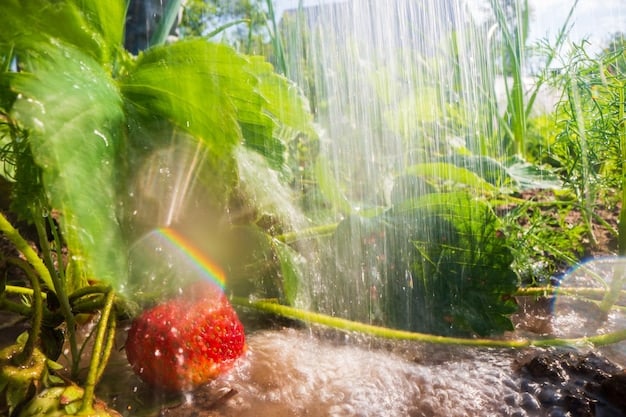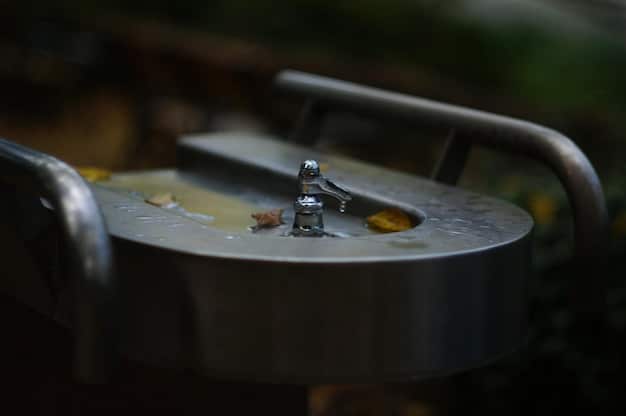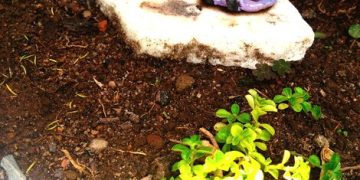Rainwater Harvesting: Collect Rainwater for Your Garden

Rainwater harvesting is the process of collecting and storing rainwater for later use, offering a sustainable way to irrigate gardens, reduce water bills, and conserve water resources during droughts.
Discover how rainwater harvesting can transform your garden into a thriving, sustainable oasis, reducing your environmental footprint and saving you money.
Why Rainwater Harvesting for Your Garden?
Rainwater harvesting is an age-old practice that’s gaining renewed attention as we seek more sustainable ways to manage our resources. It’s a simple yet effective method to conserve water and reduce your reliance on municipal water supplies.
Think of it as giving your garden the purest form of hydration, straight from the sky. Let’s dive into the numerous benefits that rainwater harvesting can bring to your garden and your wallet.
Environmental Benefits of Rainwater Harvesting
Collecting rainwater isn’t just about saving money; it’s also about making an environmentally conscious choice. Here’s how it helps:
- Reduces Strain on Municipal Water Supplies: By using rainwater, you decrease the demand on public water systems, especially during dry seasons.
- Conserves Water: Rainwater harvesting is a form of water conservation, helping to preserve this precious resource.
- Reduces Stormwater Runoff: Collecting rainwater helps to manage stormwater runoff, which can cause erosion and pollute waterways.
Economic Benefits of Rainwater Harvesting
Beyond the environmental perks, rainwater harvesting can also lead to significant cost savings. Here’s how:
- Lower Water Bills: By using collected rainwater for watering your garden, you reduce your consumption of metered water.
- Reduced Need for Chemical Fertilizers: Rainwater is naturally soft and free from minerals and chemicals, promoting healthier plant growth and reducing the need for fertilizers.
- Increased Property Value: Installing a rainwater harvesting system can be an attractive feature for potential homebuyers, increasing the value of your property.
In summary, rainwater harvesting is a win-win situation. It benefits the environment by conserving water and reducing pollution, while also saving you money on water bills and other gardening expenses.
Choosing the Right Rainwater Harvesting System
Selecting the appropriate rainwater harvesting system can seem daunting, but it’s essential for maximizing efficiency and ensuring long-term usability. Several factors come into play when determining the ideal setup for your garden.
Let’s walk through the various types of systems and the considerations you’ll need to make to choose the best one for your needs.

Types of Rainwater Harvesting Systems
There are primarily two types of rainwater harvesting systems:
- Rain Barrels: These are simple, above-ground containers that collect rainwater from downspouts. They’re easy to install and ideal for small gardens.
- Larger Storage Tanks: These are bigger, more complex systems that can store larger volumes of water. They may be above-ground or underground and are suitable for larger gardens or properties.
Factors to Consider When Choosing a System
When selecting a rainwater harvesting system, keep the following factors in mind:
- Garden Size: Larger gardens will require more water storage capacity.
- Rainfall Patterns: Areas with higher rainfall may benefit from larger storage tanks.
- Budget: Rain barrels are generally more affordable than larger storage tanks.
- Space Availability: Consider the available space for installing the system, whether it’s above-ground or underground.
In conclusion, the right rainwater harvesting system depends on your specific needs and circumstances. Consider the size of your garden, rainfall patterns, budget, and available space to make an informed decision.
Essential Components of a Rainwater Harvesting System
Understanding the essential components of a rainwater harvesting system is crucial for ensuring its effectiveness and longevity. Each part plays a vital role in collecting, storing, and distributing rainwater for your garden.
Let’s break down the key components and their functions to give you a clear picture of how these systems work.
Gutters and Downspouts
Gutters and downspouts are the first line of defense in a rainwater harvesting system. They channel rainwater from the roof to the collection container. Regular maintenance is essential to keep them free of debris.
- Gutters: These should be clean and free of leaves, twigs, and other debris to ensure efficient water flow.
- Downspouts: Ensure downspouts are properly connected to the collection container to prevent water wastage.
First Flush Diverters
First flush diverters are devices that divert the initial rainwater runoff, which typically contains contaminants from the roof. They help to ensure that only clean water is collected.
- Function: Diverts the first few gallons of rainwater, which often contains dirt, leaves, and other pollutants.
- Importance: Improves the quality of the collected water, making it safer for irrigation.
Storage Containers
Storage containers, such as rain barrels or larger tanks, hold the collected rainwater until it’s needed. The size and type of container depend on your water needs and available space.
- Rain Barrels: Suitable for smaller gardens, typically holding 50-100 gallons of water.
- Storage Tanks: Available in various sizes, from a few hundred to several thousand gallons, ideal for larger properties.
In essence, each component of a rainwater harvesting system plays a crucial role in the overall process. From collecting rainwater to ensuring its cleanliness, these parts work together to provide a sustainable water source for your garden.
Step-by-Step Guide to Installing a Rainwater Harvesting System
Installing a rainwater harvesting system can be a straightforward process if you follow the right steps. Whether you’re setting up a simple rain barrel or a more complex system, this guide will walk you through the key stages of installation.
Let’s explore the step-by-step process for installing your rainwater harvesting system and setting up it correctly.
Planning and Preparation
Before you start the installation, careful planning and preparation are essential. This includes assessing your garden’s water needs, choosing the right system, and gathering the necessary materials.
- Assess Water Needs: Determine how much water your garden typically requires.
- Choose a System: Select a rain barrel or storage tank that suits your needs and budget.
Installation Process
The installation process typically involves setting up the gutters, connecting the downspouts, installing a first flush diverter, and positioning the storage container.
- Connect Gutters and Downspouts: Ensure gutters are clean and downspouts are properly connected to the collection container.
- Install First Flush Diverter: Place the diverter between the downspout and the storage container to filter out contaminants.
Testing and Maintenance
After installation, test the system to ensure it’s functioning correctly. Regular maintenance, such as cleaning the gutters and checking for leaks, is also necessary.
- Test the System: Check for leaks and ensure water flows smoothly into the storage container.
- Regular Maintenance: Clean gutters regularly and inspect the system for any damage.
To summarize, installing a rainwater harvesting system involves careful planning, a step-by-step installation process, and regular testing and maintenance. By following these steps, you can successfully set up a sustainable water source for your garden.
Using Rainwater Effectively in Your Garden
Once you’ve collected rainwater, it’s important to use it effectively to maximize its benefits for your garden. Knowing how to store, distribute, and utilize rainwater can make a significant difference in the health and vitality of your plants.

Let’s explore some strategies for using rainwater effectively in your garden and how you can get the most out of this valuable resource.
Storing Rainwater Properly
Proper storage is crucial to prevent contamination and ensure the rainwater remains usable. Keep the storage container covered and clean.
- Cover the Container: Prevent debris, insects, and algae from entering the water.
- Clean Regularly: Periodically clean the container to remove any sediment or buildup.
Distributing Rainwater Efficiently
Efficient distribution methods can help you make the most of your collected rainwater. Consider using a watering can, hose, or drip irrigation system.
- Watering Can: Ideal for small gardens, allowing you to control the amount of water each plant receives.
- Drip Irrigation: A more efficient method for larger gardens, delivering water directly to the plant roots.
Best Practices for Watering Plants with Rainwater
When watering plants with rainwater, follow these best practices to ensure optimal growth and health:
- Water Early in the Morning: This allows plants to absorb the water before it evaporates in the heat of the day.
- Water at the Base of Plants: Avoid wetting the foliage, which can promote fungal diseases.
In conclusion, effective use of rainwater involves proper storage, efficient distribution, and following best practices for watering plants. By implementing these strategies, you can maximize the benefits of rainwater and create a thriving garden.
Maintaining Your Rainwater Harvesting System
Regular maintenance is essential for ensuring the longevity and efficiency of your rainwater harvesting system. A well-maintained system not only provides a consistent water supply but also prevents potential issues such as leaks, contamination, and reduced water flow.
Let’s dive into the key aspects of maintaining your rainwater harvesting system to keep it in top condition.
Regular Cleaning of Gutters and Downspouts
Keeping gutters and downspouts clean is crucial for preventing debris from entering the system and clogging the pipes. Aim to clean them at least twice a year.
- Remove Leaves and Debris: Use a ladder and gloves to remove any accumulated leaves, twigs, and other debris.
- Flush with Water: After removing the debris, flush the gutters and downspouts with water to ensure they are clear.
Inspecting and Cleaning the Storage Container
The storage container should be inspected and cleaned regularly to prevent sediment buildup and maintain water quality. Cleaning frequency depends on the container’s material and local conditions.
- Check for Sediment: Look for any sediment or buildup at the bottom of the container.
- Clean Interior Surfaces: Use a brush and mild detergent to clean the interior surfaces, then rinse thoroughly.
Checking and Replacing Filters
Filters, such as those in first flush diverters, should be checked and replaced regularly to ensure they are effectively removing contaminants from the rainwater.
- Inspect Filters: Check filters for clogs and damage.
- Replace as Needed: Replace filters according to the manufacturer’s recommendations or when they appear dirty.
In summary, maintaining your rainwater harvesting system involves regular cleaning of gutters and downspouts, inspecting and cleaning the storage container, and checking and replacing filters. By following these maintenance tips, you can ensure the long-term performance and reliability of your system.
| Key Point | Brief Description |
|---|---|
| 💧 Conserve Water | Reduce strain on municipal supplies during dry spells. |
| 💰 Save Money | Lower water bills & reduce need for chemical fertilizers. |
| 🌱 Healthy Plants | Rainwater is naturally soft, ideal for plant growth. |
| 🛠️ Easy Setup | Simple systems like rain barrels are easy to install. |
Frequently Asked Questions
▼
Yes, rainwater is generally safe for all types of plants because it is free from chemicals and minerals that are often found in tap water. However, ensure your roof isn’t treated with harmful substances.
▼
The amount of rainwater you can collect depends on the size of your roof and the amount of rainfall in your area. A 1,000 square foot roof can collect about 600 gallons of water from 1 inch of rain.
▼
Rainwater can be potable with further filtering. If you plan to use rainwater for drinking, it’s important to install a proper filtration and purification system to ensure it’s safe for consumption.
▼
To prevent mosquitoes from breeding in your rainwater tank, ensure the tank is tightly sealed or use a screen to cover the opening. You can also use mosquito dunks or bits.
▼
You should clean your rainwater harvesting system at least twice a year, typically in the spring and fall. Regular cleaning helps to remove debris and sediment that can affect water quality and system performance.
Conclusion
Embracing rainwater harvesting for your garden is a step towards sustainability and resourcefulness. With the right system and a bit of maintenance, you can provide your plants with naturally beneficial water while conserving precious resources and reducing your environmental impact.





